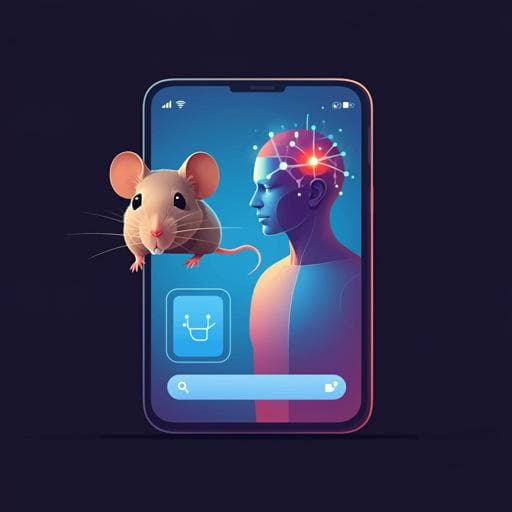
Medicine and Health
Similar cognitive deficits in mice and humans in the chronic phase post-stroke identified using the touchscreen-based paired-associate learning task
W. Z. Chow, L. K. Ong, et al.
This study by Wei Zhen Chow and team investigates post-stroke cognitive function using a novel touchscreen-based learning task. Findings reveal that chronic stroke survivors have reduced cognitive performance compared to age-matched controls, with striking parallels observed in post-stroke mice. Discover how this research could inform future therapies aimed at enhancing cognitive recovery after stroke.
~3 min • Beginner • English
Introduction
Chronic stroke survivors frequently experience persistent cognitive impairments that degrade quality of life, yet translation of therapies is hindered by disparities between human and animal cognitive assessments. Establishing validated, parallel test platforms for humans and rodents has been highlighted as a priority by the Stroke Recovery and Rehabilitation Roundtable. The CANTAB touchscreen-based Paired-Associates Learning (PAL) is a well-validated human tool sensitive to visuospatial episodic memory and hippocampal function, previously used largely in neurodegenerative disease and only limitedly in sub-acute stroke. Traditional rodent tasks (e.g., Morris water maze, novel object recognition) have limited similarity to clinical assessments and can be variable. Touchscreen operant platforms for rodents enable adapted PAL tasks with comparable cognitive processes and delivery mode to human CANTAB. Prior cross-species touchscreen studies in other conditions (e.g., Dlg gene-related cognitive impairment, Huntington’s disease) demonstrated feasibility. The research question was whether humans and mice in the chronic phase post-stroke show similar deficits when evaluated using highly analogous touchscreen-delivered PAL tasks. The study aimed to apply and compare visuospatial object-location PAL performance in chronic stroke survivors and in mice in the chronic phase after experimental stroke.
Literature Review
Background work establishes that over half of stroke survivors report cognitive dysfunction at six months, with impairments across multiple domains and potential progressive decline over years. CANTAB PAL is a validated measure sensitive to hippocampal dysfunction and useful in detecting mild cognitive impairment and predicting Alzheimer’s progression. In stroke research, CANTAB has been used primarily in sub-acute settings to assess working memory. Rodent cognitive assessments have commonly relied on tasks with limited clinical comparability and greater variability. Touchscreen-based PAL in rodents is sensitive to hippocampal lesions and cholinergic/glutamatergic manipulations and has been employed in models of Alzheimer’s disease, neuropsychiatric disorders, and stroke, including sensitivity to therapeutic interventions. Prior cross-species touchscreen studies aligned human CANTAB PAL with rodent PAL in genetic models, demonstrating translational relevance, but such cross-species comparison had not been conducted in chronic post-stroke populations.
Methodology
Human study: A cross-sectional cohort of 140 participants (stroke survivors ≥5 months post-stroke, n=70; non-stroke controls, n=70) was recruited in NSW, Australia (Nov 2017–Feb 2019) via registries and advertisements. Exclusion: pituitary or adrenal diseases. Baseline demographics included age, sex, blood pressure, BMI, waist circumference, and comorbidities. Participants completed a CANTAB Motor Screening task followed by the CANTAB visuospatial PAL task comprising four stages (2, 4, 6, 8 patterns). Outcome measures: PAL First Attempt Memory Score (PALFAMS), total errors (adjusted) at each stage and overall (PALTEA2/4/6/8, PALTEA overall), total attempts at each stage and overall (PALTA2/4/6/8, PALTA overall), and number of patterns reached at last stage. Non-normal data were analyzed with Mann–Whitney U tests. Linear regression (generalized linear model with robust SEs for non-normal residuals) assessed association between stroke status and performance, adjusting for age, gender, diabetes, systolic blood pressure, and waist circumference. Animal study: Male C57BL/6 mice (n=45; 7–8 weeks at acquisition) were housed under standard conditions (21±1°C; 12:12 h reverse light-dark). Mice were randomly assigned to sham or photothrombotic stroke. Photothrombosis: under 2% isoflurane anesthesia, 200 µl Rose Bengal (10 mg/ml) intraperitoneally (saline for sham); skull exposed; after 8 minutes, skull illuminated for 15 minutes with 4.5 mm cold light to induce focal cortical infarct. Sample size estimation used preliminary PAL correct-rate data (SD 6.146, effect size d=0.25), α=0.05, β=0.1, estimating ≥7 per group; total tested in behavior: sham n=12, stroke n=12 at 20 weeks post-stroke (6 months). Four mice (3 sham, 1 stroke) did not reach training criteria and were excluded from PAL assessment. At 19 weeks post-stroke, mice underwent habituation/training in Bussey–Saksida Mouse Touch Screen Chambers for five days, then PAL sessions for seven weeks (five days/week; 1 hour/session; up to 36 tasks/session). PAL outcomes: correct rate (%), number of correction trials, time to complete session, number of tasks per session, correct/incorrect touch latency, and reward collection latency. Analyses: Mouse PAL data averaged in blocks (mean of five sessions) across seven blocks and analyzed by two-way ANOVA with Sidak multiple comparisons; brain tissue volumes by two-sided t-test; significance p<0.05. Ethical approvals were obtained for human and animal studies; all procedures adhered to relevant guidelines.
Key Findings
Human cohort: Baseline characteristics showed similar age (stroke 61.9±13.8 years vs control 64.6±10.0; p=0.192), differing gender distribution (male 54.3% vs 34.3%; p=0.027) and higher dyslipidaemia in stroke (54.3% vs 22.9%; p<0.001). Median time post-stroke was 38.5 months (IQR 13.8–117.5). CANTAB PAL outcomes (non-parametric): - PALFAMS (first-attempt correct): stroke 9.0 (6.0, 11.0) vs control 11.0 (8.0, 14.0); p=0.002. Linear regression: stroke associated with lower first-attempt memory scores unadjusted β −2.26 (95% CI −3.62 to −0.899), p=0.001; adjusted β −2.47, p=0.001. - Attempts: stroke required more attempts overall (PALTA overall: 10.0 (8.0, 12.0) vs 9.0 (7.7, 11.0); p=0.015), and at 2-pattern (PALTA2; p<0.001) and 4-pattern levels (PALTA4; p=0.016); no significant differences at 6- or 8-pattern levels. Dropout after each level was higher in stroke (0, 3, 7, 24) vs controls (0, 0, 5, 18), not statistically significant. - Errors (adjusted): stroke made more errors overall (PALTEA overall: 24.0 (14.0, 43.75) vs 21.0 (8.0, 38.25); p=0.044) and at 2-pattern (PALTEA2; p<0.001) and 4-pattern levels (PALTEA4; p=0.008); no significant differences at 6- or 8-pattern levels. Mouse cohort (6 months post-stroke): Histology confirmed significant ipsilesional tissue loss, corpus callosum loss, sustained neuronal loss, and reactive astrogliosis in peri-infarct regions. On the rodent PAL task: - Correct rate (%): stroke 57.1±9.0 vs sham 69.1±8.7; p=0.032 at block 7; two-way ANOVA main effect of stroke F(1,18)=5.65, p=0.029; main effect of time F(6,108)=15.1, p<0.0001. Sham showed progressive acquisition; stroke mice remained near chance (~50%). - Session metrics: stroke mice took longer per session (57.7±5.67 min vs 46.1±10.9; p<0.0001) and completed fewer tasks per session (19.3±8.82 vs 34.1±2.32; p<0.0001). - Correction trials: no significant difference (stroke 15.5±4.66 vs sham 19.5±5.80; p=0.702). - Latencies: correct/incorrect touch and reward collection latencies did not differ significantly.
Discussion
The study addressed whether chronic stroke survivors and mice in the chronic phase after experimental stroke exhibit similar deficits on analogous touchscreen-based PAL tasks. Using CANTAB PAL in humans and a parallel rodent touchscreen PAL, both groups with prior stroke showed reduced accuracy and efficiency compared with respective controls, indicating a shared impairment in visuospatial episodic memory processes sensitive to hippocampal function. These findings support the translational validity of touchscreen-based PAL assessments across species, suggesting that comparable cognitive processes can be measured with similar task delivery. The results underscore the potential for using aligned platforms to evaluate mechanisms and therapeutics targeting long-term post-stroke cognitive impairment. Differences between human and rodent task implementations (e.g., training requirements, stimulus randomization, task complexity) did not preclude detection of analogous deficits. Importantly, the 2-pattern human PAL stage appeared most comparable to the rodent task demands, and both effectively detected impairment. Overall, the cross-species convergence strengthens confidence that rodent touchscreen PAL can model clinically meaningful cognitive outcomes relevant to chronic stroke recovery.
Conclusion
This study provides the first cross-species comparison demonstrating similar visuospatial PAL deficits in humans and mice in the chronic phase post-stroke using highly analogous touchscreen platforms. Stroke survivors exhibited fewer first-attempt correct choices and more errors and attempts than controls, while stroke-model mice showed reduced correct rates, longer session times, and fewer completed tasks. These findings highlight the feasibility and translational value of parallel touchscreen-based assessments to bridge preclinical and clinical research on chronic post-stroke cognition. Future work should longitudinally track cognition from the acute phase, incorporate detailed clinical stroke phenotyping and education levels, assess motor function in animals alongside cognition, and use these aligned platforms to test and refine therapeutic strategies aimed at improving long-term cognitive outcomes after stroke.
Limitations
- Human study was cross-sectional; pre-stroke cognitive status was not assessed. - Stroke cohort was heterogeneous in stroke subtype and time post-stroke, likely increasing inter-individual variability. - Clinical details such as infarct location/number and educational background were unavailable, both known determinants of cognition post-stroke. - Gender distribution and dyslipidaemia differed between groups; analyses adjusted for selected confounders but residual confounding may remain. - Rodent task requires extensive habituation/training and uses constant stimuli, potentially introducing practice effects, whereas human CANTAB employs randomized stimuli and increasing complexity. - Motor function was not assessed in mice post-stroke; although touch and reward latencies were similar between groups, potential motor influences on performance cannot be fully excluded. - Differences in task structure and rewards between species may influence performance characteristics despite conceptual alignment.
Related Publications
Explore these studies to deepen your understanding of the subject.







